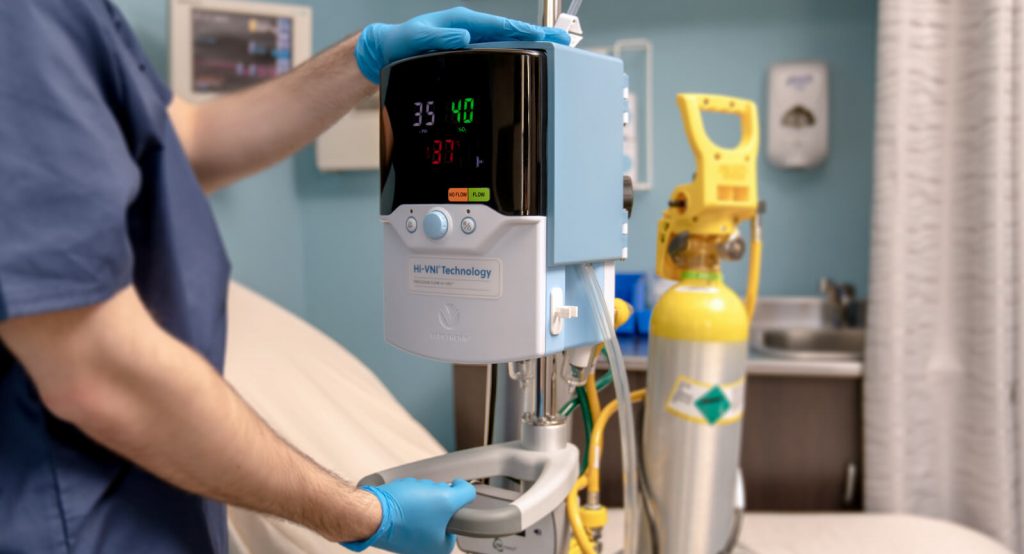Maintain Full Respiratory Support on the Go — Five Things You Can Do When You Have the Freedom to Move Your Patients

Hi-VNI® Technology is a mask-free respiratory support tool as effective as NiPPV. As such, it already brings many benefits to a hospital—it simplifies care, allowing patients in undifferentiated respiratory distress to eat, drink, speak, and take oral medications while maintaining therapy. But the benefits become even more powerful when the versatility of the Vapotherm Transfer Unit™ (VTU) is put into use.
The VTU has a light-weight, medical grade mobile power supply that lasts for up to 60 minutes and can offer Mask-Free NIV™ for spontaneously breathing patients on the move. Here are a few ways VTUs can further streamline clinicians’ workflows and increase patients’ comfort and mobility.
Transferring Patients in the Emergency Department
The Emergency Department (ED) as the triage center of a hospital needs speed and mobility. Hi-VNI Technology is one simple tool that clinicians can use to treat patients in undifferentiated respiratory distress, including hypercapnia, dyspnea, and hypoxemia,1 giving clinicians the versatility they need to treat a variety of patients with one simple tool. But ED patients rarely stay in the ED for long. With the VTU, clinicians can transfer patients within the hospital while maintaining full respiratory support. When the patient reaches the ward the Disposable Patient Circuit can be hot-swapped from the mobile VTU to a stationary Precision Flow® unit—and vice versa—at the bedside with minimal disruption of therapy. This streamlines the workflow and allows the mobile VTU to be ready for a return to the ED within minutes.
For an example of a hospital that used the VTU to streamline their workflow in the ED, read about Norman Regional’s experience.
Figure 1: Used from Doshi et al, HVNI in the Treatment of Respiratory Failure, Annals of Emergency Medicine, 2017; 1:11.
Emergency Department Boarding Made More Tolerable
Even EDs with the most streamlined workflows sometimes have to board patients waiting for a bed in the hospital. The mobility of the VTU and lack of reliance on wall air or a compressor are obvious advantages for a short period of boarding in locations not designed for patients. But the mask-free interface offers clinicians an additional potential benefit as their patients can easily communicate to family and caregivers. In a study by Doshi and colleagues, physicians rated Hi-VNI Technology as more comfortable for patients than Non-invasive Positive Pressure Ventilation1, as shown in Figure 1. The mask-free nature of the therapy, is especially useful to keep mask-intolerant patients on therapy and thereby reduces the risk of destabilization due to disruption of respiratory support during boarding.
Taking Patients for Tests or Procedures
Going along with its ability to have patients ready for transfer in minutes, it’s easy to see how the VTU is a great tool for taking patients for tests within the hospital. Clinicians can hot-swap the Disposable Patient Circuit from a stationary Precision Flow unit into the VTU and back again, or plug the VTU into nearby wall gas and electrical power when available in the test or procedure area.
Ambulating in the ICU
There are many clinical and economic benefits to ambulating ICU patients—from potentially improving patient outcomes2 to reducing length of stay and saving the hospital money3,4. Given that many ICU patients require respiratory support, the VTU is a useful tool to allow patients to ambulate. Hi-VNI Technology provides not only oxygenation, but also ventilatory support to spontaneously breathing patients. The VTU has a battery life of 60 minutes, but practitioners can expect that the duration of gas sources depends both on the patient’s L/min and FiO2 needs.
Pulmonary Rehab
Pulmonary Rehab departments can also benefit from the VTU. The comfortable mask-free interface allows patients to communicate with providers while they get the respiratory support they need to perform rehab exercises. Additionally, the mobility of the VTU ensures that the respiratory support patients need is right there with them as they move around to different exercises or equipment.
References